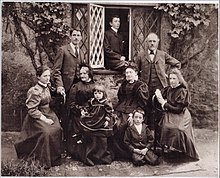Welsh Mam
The Welsh Mam (mam means "mother" in Welsh) was an archetypal image of Welsh married women, especially popular in 19th-century industrial South Wales, and depictions of that place and era.

The mythologised Welsh Mam was seen as a matriarch[1] ruling her household,[2] "the pivot, around which all family life revolved".[3] In reality many Welsh women were economically dependent on male wage-earners, and suffered poverty and ill health exacerbated by regular childbearing.[4][5]
In the news
Women described as "Welsh mams" were seen in clashes with police and organizing family relief during the Welsh Miners Strike of 1984.[6][7]
Examples in popular culture
The Welsh mam was described as "hardworking, pious and clean, a mother to her sons and responsible for the home", in Richard Llewellyn's 1939 novel How Green Was My Valley.[8] Actress Rachel Thomas often played Welsh mams in the 20th century, including roles in The Proud Valley (1940), How Green Was My Valley, Under Milk Wood, and the soap opera Pobol y Cwm.[9][10]
A 1997 World of Groggs clay figurine, titled The Welsh Mam, is in the collection of the National Museum Wales.[11]
References
- Austin, Craig (2013-11-28). "Are Mothers Saints? The Role of the Matriarch in Welsh Society". Wales Arts Review. Retrieved 2020-07-29.
- "Why Wales is as much Land of Our Mothers as Our Fathers". WalesOnline. 2016-03-05. Retrieved 2020-07-29.
- Beddoe, Deirdre (2000). Out of the Shadows: A History of Women in Twentieth-century Wales. University of Wales Press. p. 148. ISBN 978-0-7083-1591-0.
- The Welsh Academy Encyclopedia of Wales. Cardiff: University of Wales Press 2008.
- Carradice, Phil. "The role of the 'Welsh Mam' through history" BBC Wales (28 March 2014).
- Kemp, Laura (2015-03-10). "This Mother's Day Welsh Mams are just as adored as ever". walesonline. Retrieved 2020-07-29.
- Leeworthy, Daryl (2012-10-01). "The secret life of us: 1984, the miners' strike and the place of biography in writing history 'from below'". European Review of History: Revue européenne d'histoire. 19 (5): 825–846. doi:10.1080/13507486.2012.719009. ISSN 1350-7486.
- Images of Welsh Women, 15/06/07
- Ffrancon, Gwenno. "‘The Angel in the Home?: Rachel Thomas, Siân Phillips and the on-screen embodiment of the Welsh Mam’" The Transactions of the Honourable Society of Cymmrodorion 2009, vol. 16 (2010), 110-22.
- Fiddick, Peter (1988-07-04). "Mam's Welcome in the Hillside". The Guardian. p. 23. Retrieved 2020-07-29 – via Newspapers.com.
- "The Welsh Mam (sculpture)". National Museum Wales. Retrieved 2020-07-29.
External links
- Rebecca Davies, “Not Just Supporting But Leading”: The Involvement of the Women of the South Wales Coalfield in the 1984-85 Miners’ Strike (PhD thesis, University of Glamorgan 2010).
- Deirdre Beddoe, Munitionettes, Maids and Mams: Women in Wales, 1914-1939 (1991).